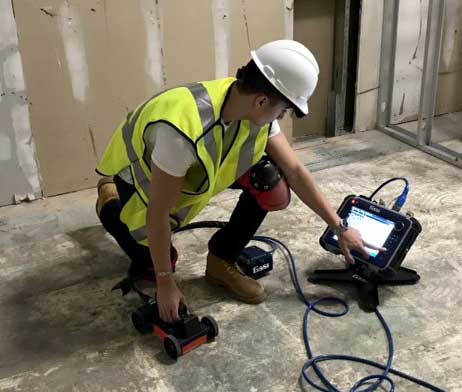RainierGPR Service Areas: Where We Offer Premier Concrete Scanning
RainierGPR Service Areas: Where We Offer Premier Concrete Scanning
Blog Article
Concrete Scanning: A Crucial Step In The Direction Of Ensuring Architectural Honesty and Security
In the world of building and construction and infrastructure upkeep, the importance of concrete scanning can not be overemphasized. This precise procedure holds the essential to introducing potential threats concealed underneath the surface of relatively solid structures. By utilizing sophisticated innovation and methods, concrete scanning acts as an essential tool in making sure that the honesty and safety of bridges and buildings are maintained to the highest standards. Nevertheless, past its surface-level effects, the duty of concrete scanning prolongs far deeper than fulfills the eye.
Importance of Concrete Scanning
Concrete scanning plays a critical role in making sure the architectural honesty and safety of structures and facilities jobs. By using sophisticated modern technologies such as ground-penetrating radar (GPR) and electromagnetic induction, professionals can non-destructively check concrete frameworks to detect possible problems, spaces, ingrained items, and reinforcement design. This procedure makes it possible for very early detection of abnormalities that could jeopardize the security of a structure, preventing pricey problems and making certain the security of passengers.
Before exploration, cutting, or coring right into concrete, scanning aids identify the exact places of rebar, post-tension cables, and other embedded aspects, decreasing the danger of accidental hits that might lead to architectural weaknesses. Furthermore, concrete scanning help in quality control by confirming the density of concrete covers and identifying any disparities that may impact the total sturdiness of the structure.
Technology for Concrete Examination

Advantages of Very Early Detection
Timely discovery of architectural issues can considerably reduce threats and make certain the durability of construction projects. By identifying prospective problems beforehand in the building procedure, stakeholders can take aggressive actions to resolve concerns prior to they intensify into bigger and much more costly issues. Among the crucial benefits of early discovery is the prevention of structural failures, which can present significant safety risks and result in project hold-ups and monetary losses.
Additionally, early detection permits prompt fixings and upkeep, which can help extend the life expectancy of the structure. By addressing concerns immediately, construction groups can prevent costly fixings or also the requirement for premature replacement of architectural components. This aggressive technique not only conserves money and time but likewise boosts the overall safety and toughness of the building and construction job.
Furthermore, very early discovery can boost job planning and decision-making by offering stakeholders with important insights into the problem of the structure. Armed with this info, task managers can make educated options concerning construction timelines, materials, and methods, bring about more efficient and effective job results.
Ensuring Architectural Security
Ensuring the architectural stability of a construction task is paramount to its safety and security and long life. Structural security describes the capacity of a structure or framework to maintain its type and function under environmental problems and numerous loads. To attain this, comprehensive assessment and tracking of the structure are necessary. Concrete scanning plays an important function in ensuring architectural security by discovering possible issues such as spaces, delamination, or support deterioration that might jeopardize the stability of the structure over time.
By making use of Learn More Here sophisticated scanning technologies like ground-penetrating radar (GPR) and electromagnetic induction, building and construction specialists can non-invasively examine concrete structures to determine locations of concern beneath the surface. This proactive strategy enables for the very early detection of problems or weak points, enabling timely repair work or reinforcement to stop architectural failures.
Regular concrete scanning during different building phases and throughout the life cycle of a structure can assist maintain its stability, alleviate threats, and ensure the security of owners. By focusing on architectural security with concrete scanning, construction projects can improve their strength Get More Info and resilience, ultimately adding to greater safety and longevity.
Stopping Important Failures
To protect versus disastrous occasions, thorough tracking and proactive maintenance are vital in averting vital failures within architectural structures. Identifying potential problems before they rise is vital to avoiding structural failures. Implementing regular evaluations, such as concrete scanning, can reveal hidden defects like gaps, cracks, or corrosion that could endanger the stability of a structure. By making use of innovative scanning innovations like Ground Passing through Radar (GPR) or Concrete X-ray, designers can non-destructively evaluate the condition of concrete and identify weak points that call for support or repair service - RainierGPR Service Areas.

Conclusion
In verdict, concrete scanning plays a vital role in making certain architectural stability and safety by utilizing sophisticated modern technology for very early detection of prospective concerns. This proactive technique helps stop critical failings and ensures the stability of frameworks. It is necessary to focus on concrete examination as a common technique to secure the durability and safety of buildings and facilities.
Concrete scanning plays a critical role in making certain the architectural integrity and safety of structures and facilities jobs. In addition, concrete scanning aids in top quality control by verifying the thickness of concrete covers and identifying any type of discrepancies that may affect the general sturdiness of the structure. Concrete scanning plays a crucial duty in guaranteeing structural security by detecting possible problems such as voids, delamination, see here now or reinforcement corrosion that could endanger the stability of the structure over time.

In final thought, concrete scanning plays a vital role in ensuring structural stability and security by utilizing innovative innovation for early discovery of possible concerns.
Report this page